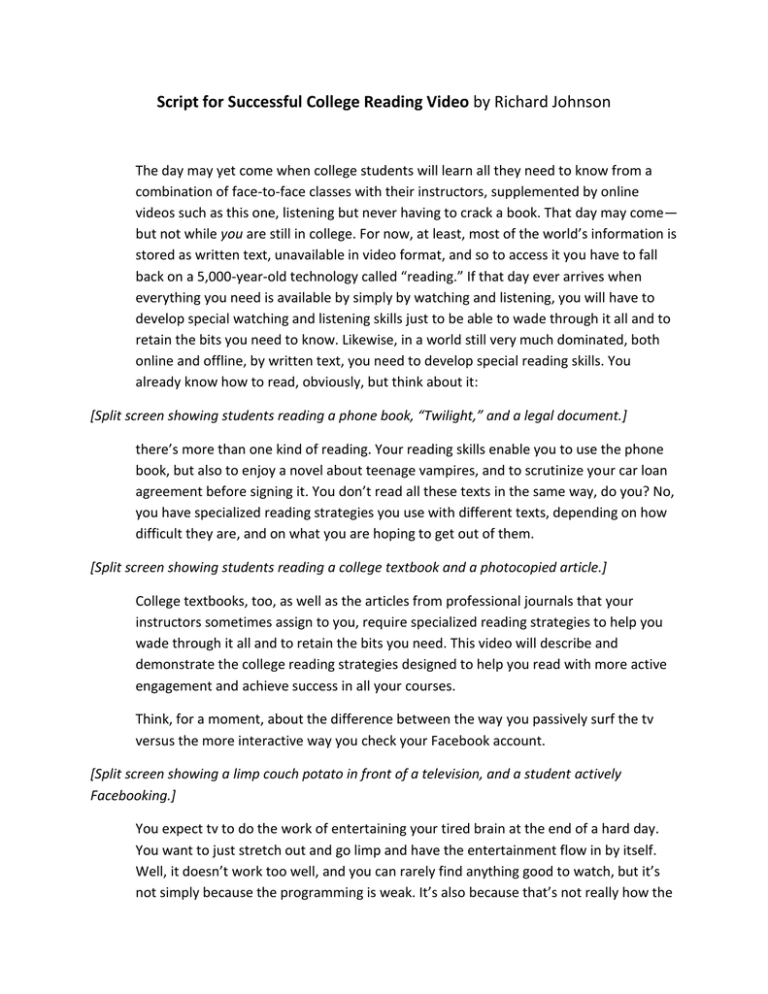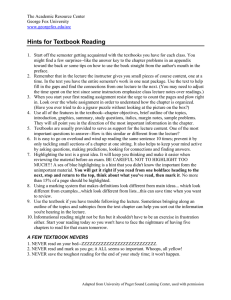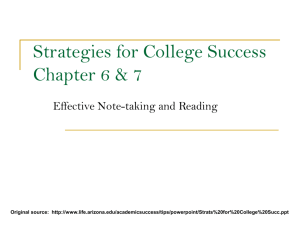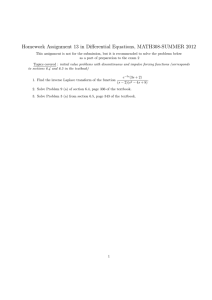Script for Successful College Reading Video
advertisement

Script for Successful College Reading Video by Richard Johnson The day may yet come when college students will learn all they need to know from a combination of face-to-face classes with their instructors, supplemented by online videos such as this one, listening but never having to crack a book. That day may come— but not while you are still in college. For now, at least, most of the world’s information is stored as written text, unavailable in video format, and so to access it you have to fall back on a 5,000-year-old technology called “reading.” If that day ever arrives when everything you need is available by simply by watching and listening, you will have to develop special watching and listening skills just to be able to wade through it all and to retain the bits you need to know. Likewise, in a world still very much dominated, both online and offline, by written text, you need to develop special reading skills. You already know how to read, obviously, but think about it: [Split screen showing students reading a phone book, “Twilight,” and a legal document.] there’s more than one kind of reading. Your reading skills enable you to use the phone book, but also to enjoy a novel about teenage vampires, and to scrutinize your car loan agreement before signing it. You don’t read all these texts in the same way, do you? No, you have specialized reading strategies you use with different texts, depending on how difficult they are, and on what you are hoping to get out of them. [Split screen showing students reading a college textbook and a photocopied article.] College textbooks, too, as well as the articles from professional journals that your instructors sometimes assign to you, require specialized reading strategies to help you wade through it all and to retain the bits you need. This video will describe and demonstrate the college reading strategies designed to help you read with more active engagement and achieve success in all your courses. Think, for a moment, about the difference between the way you passively surf the tv versus the more interactive way you check your Facebook account. [Split screen showing a limp couch potato in front of a television, and a student actively Facebooking.] You expect tv to do the work of entertaining your tired brain at the end of a hard day. You want to just stretch out and go limp and have the entertainment flow in by itself. Well, it doesn’t work too well, and you can rarely find anything good to watch, but it’s not simply because the programming is weak. It’s also because that’s not really how the brain likes to relax, passively like that. The brain prefers to go out and make its own enjoyment by staying actively engaged. [Reduce the couch potato screen. Expand the Facebooking screen.] So you log into Facebook or Twitter instead, where you can mingle your thoughts with those of your friends, summarizing your current activities or your current state of mind, asking questions about theirs, responding to something someone else has posted, and so on. You may find Facebook more interesting and more entertaining—not because there is more going on there than on tv, but because interest comes from pursuing it, not simply from receiving it passively. Nothing is interesting or boring all by itself. Things become interesting if you pursue them with interest. Participation, involvement, curiosity: these are not the effects of something being interesting. They are what cause us to experience interest in the first place. And you can control them. There is an important lesson here. If a college textbook seems boring to read, the boredom may be not so much in the book as in the way you are reading it. If your professor hands out a so-called “interesting” article for you to read and it doesn’t seem very interesting to you, it may well be that the problem lies not in the interesting article but in the boring way you read. You have to learn to read it with interest, that is, to read with a stake in it, like it matters to you, the way you read your friends’ Facebook postings. You do not have to be at the mercy of boring textbooks, slogging your way through them and forgetting most of what you read. Instead, you can learn to approach texts with interest, learn to read with active engagement. It will help you dread studying less, and it will help you retain more of what you study. Don’t think for a moment that you just don’t have the “head” for reading college-level material. If you’ve got a human brain, you’ve got the latest hardware already. The mind is not some empty bucket you just try to fill with knowledge; it is a surveying, questioning, predicting, summarizing machine. Sitting back passively and “soaking it all up” is not going to cut it. What you need is a reading strategy that complements and works with that fine machine, rather than against it. What you need is a software upgrade for your 5,000-year-old reading technology because, let’s face it, it is your approach to reading texts that will make or break your success in college. So let’s get started. [Title card: Previewing] The mistake many students make, after long avoiding the task of sitting down and doing the reading, is to jump right in and read straight through to cover some ground—as if to make up for all the time they may have already wasted. But actually, you should not just jump in and start reading. What you should do is preview the text. Research on reading shows that previewing what is coming in a chapter or an article helps increase your attention as you read and your retention afterwards. Previewing a chapter is like giving yourself a glance at the whole picture before you start focusing on the individual parts. Different reading matter calls for different reading strategies. Looking ahead through your textbook chapter will not spoil the surprise. What it will do is prepare you, for a more careful subsequent reading, by giving you an early glimpse into what this text is about. [Student previewing a chapter by flipping through the pages and occasionally pausing to notice its features] To preview a textbook chapter or an article your professor has assigned, begin by considering the title and any subtitles. The authors came up with that title for a reason; what does the title suggest about the piece you are about to read? [Close-up of the first page of a textbook chapter.] Now read the opening to the chapter—just the introduction, the first paragraph, maybe the second if it seems still to be introducing the chapter. You should read every word of the introduction, but for the paragraphs that follow we are going to switch into high gear, reading only the first and last sentences of every paragraph. This does not take long at all; your eyes can just fly right through a page. Section headings, too, which are often printed in somewhat larger, boldface font, will help you see how a group of paragraphs hang together to make up a section of the chapter. By paying attention to the headings, and by reading just the first and last sentence of each paragraph, you can quickly get an overall grasp of what the whole chapter will be about. This is not so that you can then skip reading the chapter in full! Previewing gives your brain a little map of the terrain in advance, so that when you do start reading the full paragraphs, you will read them more effectively. Previewing helps you get a tentative fix on the meaning of the text; you form a mental outline of the chapter before you read it. Your subsequent reading, then, will be easier because you have that mental outline. Comprehension and concentration will improve, and you will be able to remember more of what you read. As part of this previewing stage, you should also take not of any typographical cues the authors are trying to give you. For example, key words for you to learn are often written in boldface type. Take note of them; they’ll be on the test. Authors often use italics to emphasize important information. Phtographs, charts, or diagrams have been included to provide additional information to support and illustrate the ideas of the chapter; see if you can’t make some sense of the visual graphics before you have even read the text. And finally, read the summary at the end of the chapter or article. Textbook chapters nearly always wrap up with a review section; in fact, long chapters might have several such summary sections along the way. For an article, if there is no review section, just read the closing paragraph. But always pay special attention to the conclusion, since this is where a writer is likely to make or to reiterate key points. And that’s all there is to previewing. It is just a quick sizing up, surveying the scene. Previewing gives your brain the lay of the land, an overall gist of the chapter—and having that gist already in hand going in will help you read more effectively. [Title card: Considering What You Already Know] You have done a quick once-over of the text; now it is time to do a quick once-over of yourself in relation to the topic. Reading is a two-way street; the text presents the writer’s ideas, but readers also bring their own responses and interpretations to what they read. Pause to take stock of what you already know about the subject. Think about your own expectations for reading. Ask yourself what assumptions you bring to the topic, what you believe about it, and why you believe it. Locating yourself in relation to the text enables you to connect it to your own experience, and helps you to be alert to your own preconceptions. You expect the writer of the text to be fair, honest, and self-aware; so too should you expect nothing less from yourself, as reader of the text. Probably you have read other texts on the topic, or spoken to others about it previously. You will learn the new material more efficiently if you can connect it to information you already have. Even a little bit of background knowledge can help you to retain new information better, so take a moment to consider what knowledge of the topic, or opinions about it, you might already have. [Title card: Posing Questions to Guide Your Reading] Textbooks and instructors pose questions for you routinely, asking you to recall facts, to present analyses, to offer judgments. Their questions can stimulate your thinking—but unless you yourself become part of the question-generating process, you will always feel a bit on the outside of your own learning. In college, it’s not enough simply to respond to someone else’s questions; you have to learn to create them yourself. This is especially important when an instructor hands out an article to supplement your reading of the textbook. Such articles rarely provide questions to guide you to their key concepts; you have to do it yourself. Research shows that we read with better understanding if we do it for the purpose of answering questions. So, immediately after previewing the text and taking stock of your own related knowledge, create a list of questions that come to mind based on your preview of the text. The ultimate goal of this strategy is to make reading less like a long, uninterrupted monologue, and more like a conversation between you and that author. Just as you would listen to a friend recounting a weekend event—cutting in to ask for clarification, for further detail, for explanation—so too should you read your college texts. Composing questions as you read keeps you active and engaged in your reading as you seek to answer your own questions. [Student writing questions in the margins of a textbook chapter.] One very useful strategy is to turn the title of the whole piece, as well as each section heading, into a question. By reading a section, you should be able to answer the question you posed from its heading. By the time you have read the entire article or chapter, you should be able to answer the question you posed from its title. Writing the questions in the margin of the text will make it easy to relocate important ideas later. Some students find it useful to write such questions in their notebook, with space beside each question so that they can go back and answer each one with a brief summary; this is an excellent way to make your own study guide for tests. Most textbooks include discussion questions, and even suggested writing assignments, at the end of each chapter. But let such published questions be a supplement to your own, not a substitute. Ultimately, your reading will best remain engaged if the questions you seek to answer are largely of your own making. All these strategies are designed to help you gain control of your concentration, because sustained concentration is a necessary condition for you to learn to do close, effective, analytical reading. So, you’ve prepared your mind to engage with the text: you’ve previewed it, made connections with what you already know, and posed questions you expect to have answered. It has taken a few minutes, but you are much better prepared for the task, now, of reading the text in full. First, let me give you some advice. I know you probably won’t heed this advice, but I’m going to say it anyway: [Student putting away cellphone, closing laptop, removing iPod.] put away your cellphone, close your laptop, pull your earbuds out or, at the very least, switch to some music without lyrics. All these distractions do nothing but interrupt your reading and slow the whole thing down. The human brain cannot attend to multiple pieces of language simultaneously. Each time you glance up at a text message, or at a new Facebook posting, or hear the words of your current favorite song on your iPod, each time, you create a mental delay as your mind has to refocus its attention to the text you are attempting to read—and it adds up! [Student closing a textbook, pushing it deliberately away, and putting in iPod earbuds.] A better idea is to use these things as small rewards: “After I finish this section, I can check my text messages. After I finish this chapter, I can log into Facebook for ten minutes.” Little rewards like that can help get you through a long study session—just remember what mama tried to teach you, the reward has to come after the task! [Title card: Annotating and Highlighting] Read with a pen in your hand at all times. The pen is for marking in your book. Let me address a likely concern right now: Some students object that writing in books is just wrong. A decade of schooling in which we were not permitted to make any sort of marks in books has filled many of us with anxiety. But these are not the school’s books. And these are not library books. These are your books. Make them yours by putting some of your own thinking into them. To annotate a text is to respect it enough to give it serious attention—to question it, to assume that it is not the last word on the topic. Think of it this way: if you were the author, would you rather see a clean, blank copy of your book that looks like it has never even been read, or would you rather see a marked up, dog-eared, thought-through copy that revealed how much you were coming across to your reader? I have heard students say they don’t want to write in their textbooks because doing so will lower the resale value of their books. It might, if you sell them online. But if you sell your books back to the campus bookstore, it is most decidedly not true. The college bookstore does not pay you any less for a marked book than for an unmarked book. If you don’t believe me, go ask them. College bookstores expect you to have written in your textbooks. There are two kinds of markings good readers make as they read: [Close-up of a student highlighting lines of a textbook chapter.] highlighting, either with a colored marker or just by underlining with a pen, to make the most important ideas stand out from the rest of the sentences; and annotating, which involves recording your thoughts in the margins as you read. If you have turned the section headings into questions and written those questions in the margins, then you have already begun to annotate. But there are more kinds of annotations as well. Here are some of the kinds of annotations I see my own students using every day. In addition to the preview questions, they record insights they have as they read, or connections they make to other readings. They number the subpoints the writer is making, 1st, 2nd, 3rd, and so on. And if a writer supports a main point with a series of examples or illustrations, my students number those examples. They write in the definition of an unfamiliar but important word. They make comments when they notice an author’s biases or assumptions. They draw additional attention to alreadyhighlighted sentences by making a star or asterisk, or by drawing a vertical line in the margin if the interesting passage is somewhat long. They draw arrows to connect related points. They put a question mark when some part of the text confuses them—so that they know to doubleback to this difficult passage later, or to ask a question about it in class. They put an exclamation mark beside something surprising, a smiley face beside something pleasing or funny. There is no one method of annotating, any more than there is only one way of having a conversation. The point is that you, the reader, are not just passively taking in this writer’s words. By reading with a pen in your hand, by highlighting and annotating, you are letting your brain engage in a conversation with what you’re reading. You have to think about what you are reading—and that thinking process fixes your attention and aids recall. [Student variously highlighting and annotating a textbook chapter.] Highlighting and annotating are habits to improve your understanding of what you read, and to record your own thinking in response to what you read. Once you have highlighted and annotated a text, your markings provide an easy way to locate information without having to re-read. Since the purpose of highlighting is to make some passages stand out from the rest, highlighting too much will defeat that purpose. Force yourself to choose carefully what to highlight. Moreover, highlighting alone, without annotation, does not ensure comprehension. Restating the key ideas in the margin, with annotations, is more effective. [Title card: Reviewing and Summarizing] Everybody knows it’s important to review course material before exams, but the best time of all to review is while you are reading and just as soon as you finish reading it. Look first at the question you previously wrote in the margin. Make a prediction. What do you, right now, think the answer will be? Read the block of text, with a pen in your hand, and look for passages that answer your question. Was your prediction accurate? Was your question a little off track, not quite what the section turned out to be about? [Student writing a few sentences in a notebook.] After reading, highlighting, and annotating a single block of text, take just a moment to write in your notebook a two- or three-sentence summary of that block of text. In short, and in your own words, what is the text’s answer to the question you posed? If any key vocabulary terms were introduced in that block of text, write them down in your notes, say them out loud, and write a definition in your own words. If you find it difficult to summarize the text and to define key terms in your own words, it’s a sign that you do not yet have a solid grasp on the material. Better to find out now than on a quiz. You may think you understand what you have just read, but the proof is in the summary. If you can’t say it back, you don’t get it yet. Once you get to the end of the text, it is tempting to close your book and reward yourself for finishing the assignment. Even just a few minutes more invested in this assignment will pay big dividends in the amount of information that actually becomes fixed in your memory. You’ve done the hardest part; now don’t blow the finish. [Student slowing flipping through a textbook chapter, pausing long at each page.] See if you can answer your questions without re-reading the text, and without checking the summaries you wrote. Glance at the text or at your section-summaries only if you can’t answer the question on your own. And then, finally, take just a moment to write in your notebook a paragraph-long summary of the chapter as a whole. Don’t take the short-cut of copying out the chapter’s own summary, if it has one. Consult the chapter’s summary only to make sure you haven’t left anything out. The summaries you create may be your best possible study guide for exams. You may find it useful, too, to review your summaries of a chapter right before class; that way, you’ll go into the lecture or discussion with the assigned reading fresh in your mind. This all sounds like a great study strategy that would take entirely too much time, doesn’t it? Well, it does take some time. There is an important difference between taking time and wasting time. The reading strategies I have described do take time. But to force-read a chapter the old-fashioned way, with your eyes wandering back over the same unheard sentences again and again but with your brain neither understanding nor remembering what your eyes passed over—that’s a waste of time. Your goal should be not to read quickly but to read well. Don’t think of a college text as something you have to get through but as something you have to get inside yourself. The quickest way to get it into you is for you to use these strategies to help you get into it. Acknowledge that college reading is difficult; accept the reality that it will take more time and more effort than is comfortable. No one ever promised college would be easy. If it were easy, you wouldn’t be getting your money’s worth. You wouldn’t be getting your learning’s worth. The readings for your classes are hard and take a lot of time. So what? Go in fighting and put up a struggle.




